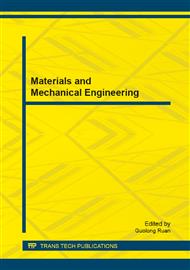[1]
Kun Li, Jinhua Li, Jinchun Li, et al. Fabrication and properties of PLZT ceramic fiber/epoxy 1-3 composites. Journal of Inorganic Materials, 19(2004, 2) 361-366. In Chinese.
Google Scholar
[2]
Ramanan Venkatesh, Sutapa Roy Ramanan. Influence of processing variables on the microstructure of sol–gel spun alumina fibres. Materials Letter, 3(2002) 189-195.
DOI: 10.1016/s0167-577x(01)00644-9
Google Scholar
[3]
Ramanan Venkatesh, Sutapa Roy Ramanan. Effect of organic additives on the properties of sol-gel spun alumina fibres. Journal of the European Ceramic Society, 11-15(2000) 2543-2549.
DOI: 10.1016/s0955-2219(00)00135-7
Google Scholar
[4]
Yongzhi Zhang, Hongxia Li, jialin Sun, et al. Influences of polyvinyl alcohol on A95-polycrystalline-alumina fibers synthesized. Journal of Shenyang University of Technology, 33(2011, 1 ) 55-61. In Chinese.
Google Scholar
[5]
J. Chandradass, M. Balasubramanian. Sol–gel processing of alumina fibres. Journal of Materials Processing Technology, 3(2006) 275-280.
DOI: 10.1016/j.jmatprotec.2005.11.030
Google Scholar
[6]
Birchall, James D. Morton, Michael J. US Patent 4, 320, 074. (1982).
Google Scholar
[7]
Jianfeng Zhang. Preparation of alumina based continuous ceramic fibre. Master dissertation of Shan dong University (2004). In Chinese.
Google Scholar
[8]
Qianjun Huang, Xiaojun Chen, Lifu Chen. Preparation of the polycrystalline alumina fibers by sol-gel progress. Journal of Xiamen University, 45(2006, 3) 375-378. In Chinese.
Google Scholar
[9]
Yongzhi Zhang, Hongxia Li, Jialin Sun, et al. Influences of Al3+/Cl- on poly aluminum chloride performances. J. Huazhong Univ. of Sci. & Tech. (Natural Science Edition), 6(2010) 116-119. In Chinese.
Google Scholar
[10]
Yongzhi Zhang, Hongxia Li, Jialin Sun, et al. Influences of polyvinyl alcohol additions on properties of Al2O3- SiO2 sols. Naihuo Cailiao. 4(2010) 247-250, 255. In Chinese.
Google Scholar
[11]
Yongzhi Zhang, Hongxia Li, Jialin Sun, et al. Influences of the percentage content of alumina, viscocity of sol,and rotating speed of the rotating disk on the diameter of gelfiber. Industrial Furnace, 32(2010, 2) 37-40. In Chinese.
Google Scholar
[12]
Zhiming Wang, Hao Wang. The fourier transform infrared absorption spectra of the Al2O3- SiO2 sol. Glass Fiber,1(2000) 6-8. In Chinese.
Google Scholar
[13]
Xiangdong Hao, Xinwei Wang, Hongbo Zhu. Preparation of aluminosilicate refractory fibers by using sol-gel process. Hi-Tech Fiber & Application,28(2003, 3) 39-42. In Chinese.
Google Scholar
[14]
Low I. M. ,McPherson R. Crystallization of gel-derived alumina and alumina-zirconia ceramics. Journal of Materials Science,24(1989, 3) 892-898.
DOI: 10.1007/bf01148774
Google Scholar
[15]
Keyou Wang. Flocculate mechanism analysis of poly-aluminum-chloride. South Smelting Technology,6(1999, 5) 23-25. In Chinese.
Google Scholar
[16]
Baoyu Gao, Qinyan Yue, BingjianWang, et al. Structure characterization and coagulation effect of nano-sized poly-aluminum-chloride with high content of Al13 species. China Environmental Science,23(2003, 6) 657-660. In Chinese.
Google Scholar


